Alternative media has become a big deal lately. It’s all about giving a voice to different views in the media world. Independent and community media are key players here. They focus on groups that are often ignored.
These media types are all about getting people involved and supporting social change. They offer a space for new political ideas and help keep democracy alive.
Community media tries to avoid the commercial side of things. It builds trust locally and gives a voice to alternative views. This kind of media is great at highlighting important social issues that big media often misses.
The big media companies hold too much power, which slows down progress. Alternative media tries to speak truth to power but faces big challenges. They often don’t have enough money to keep going.
Key Takeaways
- Alternative media prioritizes the interests of marginalized or underrepresented groups
- Independent media and community media are examples of alternative media
- Alternative media focuses on community engagement, participatory culture, and social movements
- Community media promotes local trust and provides alternative political voices
- Alternative media faces challenges in remaining critical of power while having limited access to financial resources
- Alternative media plays a crucial role in promoting democratic values and addressing social issues
- Community media and independent media are essential components of alternative media
Understanding Alternative Media Fundamentals
Alternative media is key in fostering participatory culture and backing social movements. It gives a voice to many, challenging the usual stories and power. This media lets communities share their stories, questioning the status quo.
It focuses on community, critical thinking, and understanding media. These outlets often get by on donations or small ads. Despite this, they’ve been crucial in fighting for justice and supporting the underdog.
Examples include independent papers, community radios, podcasts, and social media. They help highlight important issues like the environment and human rights. They also give a voice to those ignored by big media.
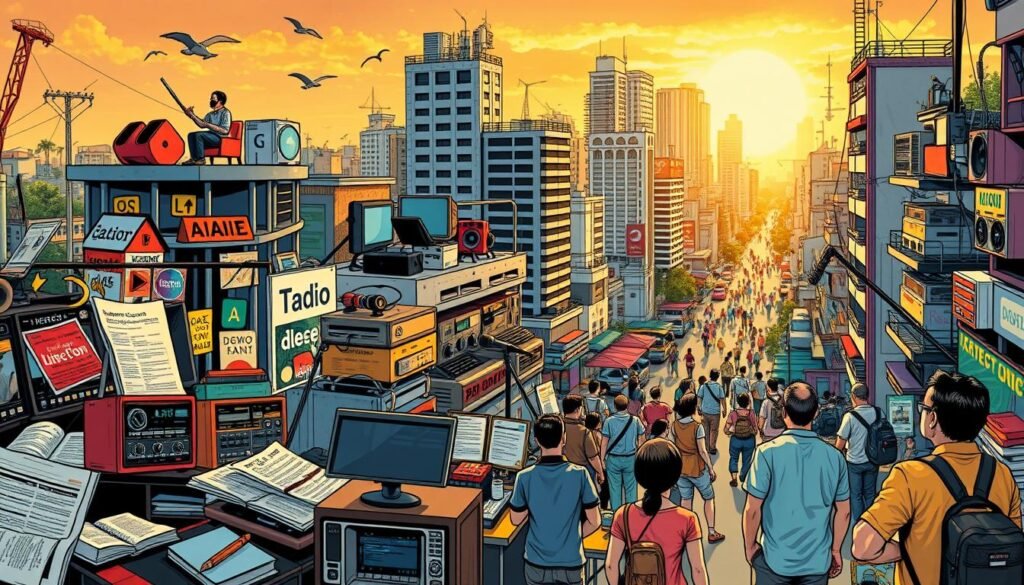
Alternative media has been a big help in social movements, like the Civil Rights Movement. It amplifies marginalized voices, pushing for fairness and rights. It also challenges common views, encouraging us to think and learn more about media.
Some key benefits of alternative media are:
- Promoting participatory culture and community involvement
- Supporting social movements and fighting for justice
- Giving a stage for different views and stories
- Encouraging critical thinking and media savvy
In summary, alternative media is essential for diversity, fairness, and justice. Its role is too important to ignore.
The Historical Evolution of Media Landscapes
The media scene in the Philippines has changed a lot over time. This change is due to the need for more diverse views. The democratization of media has played a big role, with new media outlets and online platforms emerging. But, it also shows how crucial media literacy is in today’s complex media world.
Recent stats show the Philippines has low trust in mainstream media, with only 22% getting news from newspapers. Yet, 94% of 18- to 29-year-olds use the internet. This opens up chances for alternative media to spread and teach media literacy to more people.

The rise of alternative media in the Philippines is driven by the need for different views. This has led to more online platforms and social media, key for democratization of media and media literacy. As media keeps changing, it’s vital to value media literacy for better thinking and informed choices.
| Year | Internet Users | Social Media Users |
|---|---|---|
| 2018 | 67 million | 60 million |
| 2019 | 73 million | 70 million |
| 2020 | 79 million | 75 million |
The data shows fast growth in internet and social media use in the Philippines. This is a great chance to promote democratization of media and media literacy. As media evolves, it’s key to understand the role of media literacy in fostering critical thinking and informed choices.
Alternative Media in the Digital Age
The rise of online media has changed how we get and share information. Social media has made digital activism a big part of alternative media. It lets people and groups get support and push for change.
In today’s world, alternative media is key. It gives a voice to those who are often ignored. Social media like Twitter and Facebook help these outlets reach more people. They also find new ways to connect with their audience.

Online alternative media includes blogs, podcasts, and independent news sites. These are crucial for digital activism. They give a platform to those overlooked by mainstream media.
Alternative media has a big impact today. It helps social movements grow and organize. Online media lets these movements reach more people. It makes it easier to spread their message.
The Role of Technology in Media Democratization
Technology has been key in media democratization. It helps alternative media reach more people and challenge big stories. The role of technology in this area is complex, with both good and bad sides. Social media, for example, lets citizen journalists and independent news sites share their stories and connect with readers.
Technology helps bridge gaps between communities and gives everyone access to info. But, not having technology or internet access can make social and economic gaps worse. For example, at least 24 million Americans don’t have fast internet, and more can’t afford it than those without access.
Using technology in media democratization brings many benefits. These include more info for everyone and a wider range of voices. Some of these benefits are:
- Increased access to information
- A more diverse range of voices
- Greater opportunities for citizen journalists and independent news portals

In conclusion, technology can greatly impact media democratization. But, its effect depends on many things, like internet access and how well people use technology.
Alternative Media’s Impact on Social Movements
Alternative media has been key in shaping social movements worldwide. It gives a voice to those often ignored, helping to organize grassroots efforts. The Arab Spring and Egypt’s 2011 revolution show its power in sparking global protests.
Alternative media lets activists share their views and rally support. Its impact includes:
- Providing a platform for marginalized voices to be heard
- Enabling community mobilization and grassroots campaigns
- Facilitating the organization of protests and demonstrations
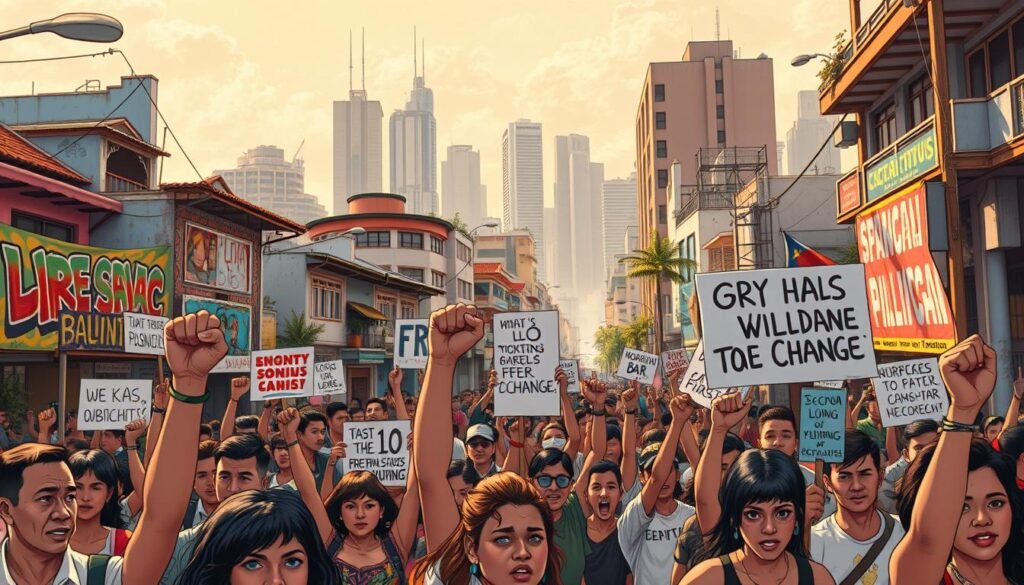
In summary, alternative media is crucial for social movements and community mobilization. It empowers marginalized voices, leading to real social change.
Philippine Alternative Media Ecosystem
The Philippine media scene has changed a lot lately. The alternative media ecosystem in the Philippines is key in pushing for social change. With about 45% of people online, there’s a huge audience for these media outlets.
The media mix in the Philippines includes both old and new sources. Online news sites and independent papers are becoming more popular, especially with the young. Over 120 million people use mobile phones, adding to the media landscape.
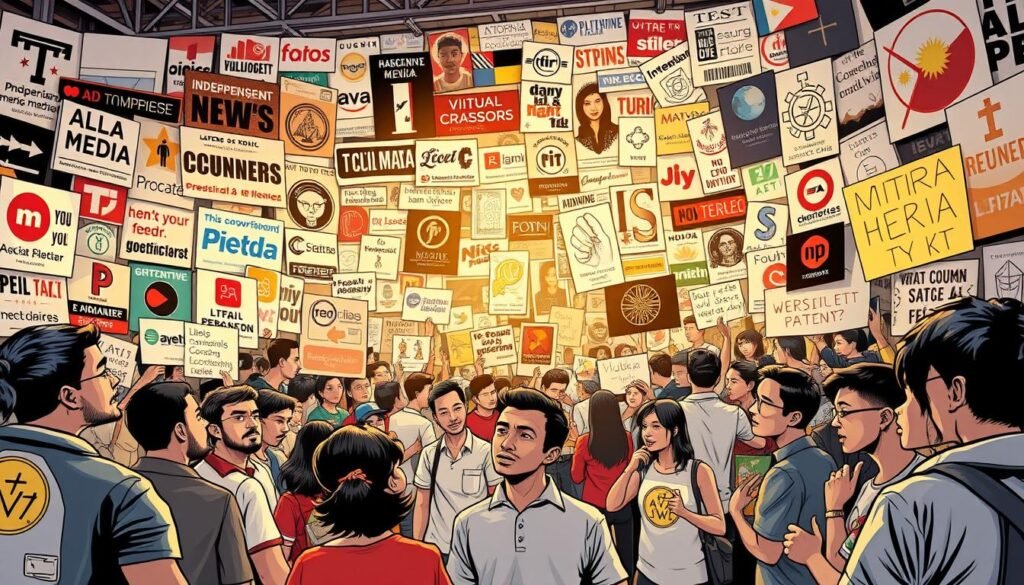
Some key features of the Philippine alternative media ecosystem include:
* A growing number of online news portals and independent publications
* Increasing use of social media platforms for news dissemination and discussion
* A strong presence of community-based media outlets, such as radio stations and print publications
* Collaboration between alternative media outlets and civil society organizations to promote social change and advocacy
The Philippine alternative media ecosystem is lively and diverse. It offers different views and voices. As media keeps changing, alternative media will likely become more important in shaping public opinion and pushing for change in the Philippines.
Independent Content Creation and Distribution
The media world has changed a lot with the rise of independent content. Now, creators can make and share their work without big companies. This change is thanks to independent content platforms that make it easier for everyone to get involved.
The podcasting world is a great example of this shift. It lets people and groups share audio with listeners all over the world. Podcasts have become a favorite way for independent creators to connect with fans and share their stories.
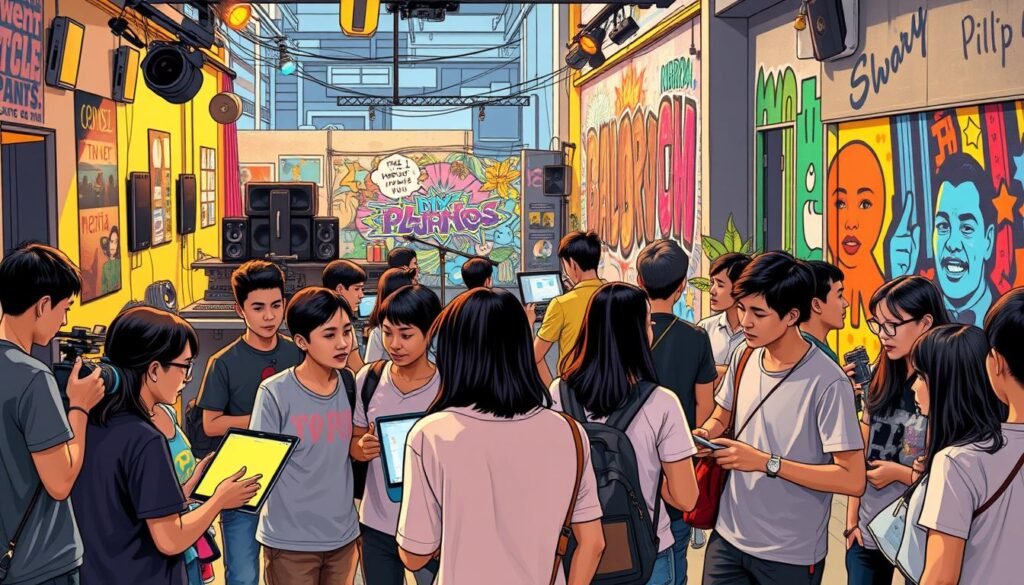
Other places like video sites and new publishing ways have also become key for creators. They let people share all sorts of content, from videos and blogs to podcasts and online classes.
Some big pluses of making and sharing content on your own include:
- More variety and new ideas in media
- It’s easier for creators and listeners to find each other
- Niche and special content can really take off
The Economics of Alternative Media
Alternative media economics is complex, with many outlets struggling to stay financially sustainable. The term “alternative media” can mean different things to different people. Some see it as only left-wing media, but it can also include conservative and repressive outlets. All these face challenges in staying independent from state, market, and capital.
The World Association of Community Radio Broadcasters (AMARC) says community radio should not aim to make a profit. Instead, it should focus on social gain and community benefit. Many alternative media projects are small because they lack resources. This limits their reach and ability to create a strong counter-public sphere. For more on alternative media, check out alternative media research.
Some key traits of alternative media economics are:
- They rely on donations, crowdfunding, grants, and selling merchandise to stay independent from big corporations.
- They keep costs low, making it easier for many creators to get involved.
- They work with non-profits to help spread social justice messages.
In summary, alternative media economics is tough, but there are ways for these outlets to make money and stay sustainable. From crowdfunding to ads and sponsorships, there are options. By understanding alternative media’s economics, we can help these outlets. They aim to offer independent, grassroots journalism and give a voice to the marginalized.
Challenges Facing Alternative Media Platforms
Alternative media platforms face many challenges. One big one is credibility with their audience. A study looked at 3,692 articles and found many struggle to gain trust.
A survey of 2,751 people showed how they use media. It found that 303 frequent users come from different views. This shows the need for high journalism standards and fact-checking to win trust. A study at alternative media research agrees that credibility is key.
Some major challenges for alternative media include:
- Credibility issues: establishing trust with audiences
- Financial sustainability: securing funding to maintain operations
- Technical limitations: overcoming infrastructure and resource constraints
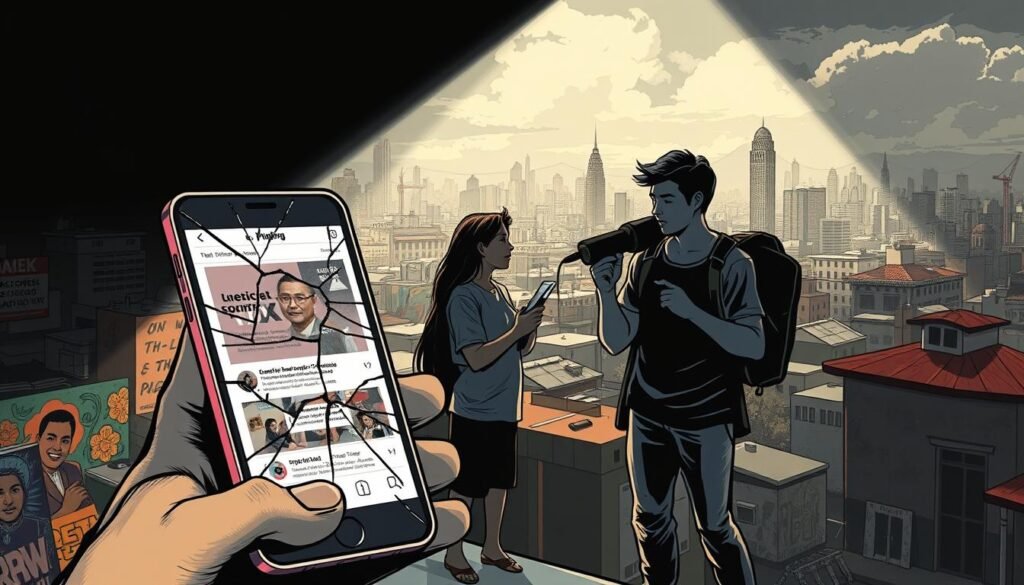
Despite these hurdles, alternative media is crucial for diversity and inclusivity. By tackling these issues and keeping journalism standards high, they can earn trust. This makes the media landscape more vibrant and diverse.
Media Literacy in the Alternative Space
Media literacy is key in the world of alternative media. It helps people understand and think critically about what they see and hear. Research on alternative media shows how important it is for critical thinking and analyzing media.
Some important parts of media literacy include:
- Critical evaluation of sources and information
- Analysis of media messages and potential biases
- Identification of misinformation and disinformation
By teaching media literacy and critical thinking, we help people make smart choices about what they watch and read. This is crucial in the alternative media world.

Studies have found that media literacy education helps students think critically. It also encourages them to join in civic discussions. So, it’s vital to focus on media literacy in schools and promote critical thinking in alternative media.
Community Building Through Alternative Channels
Building communities is key in alternative media. It helps create online groups and local networks. These groups can rally around social issues. Learning from history, these media focus on engaging with their audience. This builds a sense of belonging.
Alternative media gives a voice to those who are often ignored. For example, community radio stations in many places let locals share their stories. This has also led to online communities. Here, people can talk about and tackle social issues together.
Some great examples of community building through alternative channels are:
- Community radio stations, like Sangham Radio, focus on issues affecting the local dalit community.
- Online forums and social media groups let people discuss and tackle social issues, promoting change.
- Platforms like the Community Media Manch help train and set up community radio stations.
Alternative media outlets offer a space for community building and online groups. This helps bring about social change and empowers those who are often overlooked. It makes the media world more diverse and inclusive.
The Intersection of Traditional and Alternative Media
The world of media is changing fast, with old and new ways of sharing news mixing together. Old media is now reaching out to new media, wanting to connect with more people. This alternative media intersection has made social media very popular, with about 58% of people worldwide using it.
People spend more time online than watching TV, with 2.63 hours a day on digital media compared to 3.60 hours on TV. This change is big for the traditional media world, as it tries to keep up. Now, more people are getting news from places like TikTok and Instagram, thanks to the alternative media intersection.
Some important things about the mix of old and new media include:
- More people online and using social media
- New media getting more attention
- How people watch and get news is changing
The meeting of old and new media brings both chances and problems. As media keeps changing, it’s key to get how these changes affect us and our future.
Security and Privacy Considerations
Alternative media outlets focus a lot on keeping their content safe and users’ data protected. Security and privacy are now top priorities. They use encryption to keep content and messages safe from being watched or taken.
A survey showed that more people worry about government data use. In 2019, 64% of U.S. adults were concerned. By 2023, that number jumped to 71%.
Here are some ways to keep things secure and private:
- Implementing two-factor authentication
- Using strong, unique passwords
- Keeping software and operating systems up to date
- Being cautious when clicking on links or downloading attachments from unknown sources
To learn more about social media privacy issues, it’s important to stay updated. By following these steps, alternative media can protect their content and users’ privacy.
Alternative Media Success Stories
Alternative media has seen big wins in recent years. Many platforms have grown their followings and earned respect. Alternative media success is shown in follower numbers, how engaged people are, and its impact on big issues. For example, @underthedesknews on TikTok has over 3 million followers. It shares news with a focus on younger viewers.
Looking at Brut and Politics Joe shows how alternative media can connect with different people. Brut has a big following on YouTube, Instagram, and TikTok. Politics Joe, meanwhile, has 523,000 YouTube subscribers, appealing to a younger crowd. These case studies show how alternative media can drive change and challenge the usual stories.
Some big names in alternative media include:
- Dylan Page, who runs the biggest English-language news account on TikTok with 10.8 million followers
- Hugo Travers (Hugo Décrypte), with 2.6 million YouTube subscribers and 5.7 million TikTok followers, beating out big French newspapers
- Elon Musk, with 150 million followers on X, and Donald Trump, who has 65 million followers on X and 6.5 million on Truth Social
Future Trends in Alternative Communication
The rise of alternative media has changed how we communicate. It uses digital platforms to give a voice to many and support grassroots movements. Looking ahead, new technologies will shape how we communicate. They include artificial intelligence and virtual reality, which will change how we make, share, and interact with content.
In the Philippines, alternative media’s future looks bright. It could make society more inclusive and empower people to bring about change. Digital platforms allow alternative media to reach more people, making public discussions more open. We must think about how future trends and emerging technologies will affect communication.
Knowing about these trends and technologies helps us use them for good. As alternative media grows, staying updated is key. This way, we can navigate the changing media world and support democracy.
FAQ
What is alternative media and how does it differ from mainstream media?
Alternative media is different from mainstream media. It focuses on groups that are often ignored. It challenges the usual stories and power structures.
What are the key characteristics of alternative communication channels?
These channels focus on community and social movements. They offer diverse views and encourage critical thinking. They often use independent and community media.
How has the historical evolution of media landscapes impacted the development of alternative media?
Media has changed a lot over time. Alternative media has grown as people seek more diverse voices. Social movements have played a big role in this growth.
What role has digital technology played in the development of alternative media?
Digital tech has changed media a lot. Online platforms have helped alternative media reach more people. Social media and digital activism are key parts of this.
How has alternative media impacted social movements and community mobilization?
Alternative media has helped social movements a lot. It has helped grassroots efforts and digital activism. It gives a voice to those who are often ignored.
What are the challenges facing alternative media platforms, and how can they be addressed?
Alternative media faces many challenges. Credibility and money are big ones. To overcome these, strong teams, diverse income, and good tech are needed.
Why is media literacy important in the alternative media landscape, and how can it be promoted?
Media literacy is key for alternative media. It helps people understand and engage with different content. Education and tools can promote it.
How can alternative media outlets build and mobilize communities around social issues and causes?
They can engage communities through online spaces and events. Partnerships with groups can also help. Local networks are useful too.
What are the security and privacy considerations for alternative media outlets, and how can they be addressed?
Safety and data protection are crucial. Using encryption and protecting data are important. Basic steps like secure protocols and strong passwords help too.
What are some examples of successful alternative media outlets and campaigns, and what can be learned from them?
Many outlets and campaigns have made a difference. They show the power of alternative media. Lessons include building audiences and promoting change.
What are the future trends in alternative communication, and how will they impact the media landscape?
New tech and formats will shape alternative media. AI and VR will change content creation and distribution. Adaptation is key to keep promoting change.
Source Links
- Alternative media
- Alternative media: Alternative to what?
- International Networks of Alternative Media
- Understanding the Essence of Alternative Media: Beyond Mainstream • Journalism University
- Exploring Alternative Media: A Gateway to Diverse Voices • Journalism University
- Journal of Alternative & Community Media
- Philippines
- Philippines
- Media Literacy —
- What do we know about the rise of alternative voices and news influencers in social and video networks?
- In pursuit of truth: exploring journalistic integrity in the digital age
- Ask an expert: Democracy in the internet age | Penn State University
- Have digital communication technologies democratized the media industries?
- How Mainstream and Alternative Media Shape Online Mobilization: A Comparative Study of News Coverages in Post-Colonial Macau
- Assessing the Impact of Digital Alternative News Media in a Hybrid News Environment: Cases from Taiwan and Hong Kong
- Philippines – Foundation for Media Alternatives
- Philippine media is at a crossroads — and it’s impacting journalists
- Mainstream vs. Alternative Media: A Comparative Analysis • Journalism University
- Bridging the Gap: New Media as a Platform for Alternative Discourses • Journalism University
- Social Media and News Fact Sheet
- Alternative Media: For, within, or against capitalism
- Alternative Media: Definition & Techniques
- Title
- Stephen Cushion, Beyond Mainstream Media: Alternative Media and the Future of Journalism
- The Role of Alternative Social Media in the News and Information Environment
- Information Wars: A Window into the Alternative Media Ecosystem
- Media Literacy for Students in a Digital Age | Citizenship | Carnegie Corporation of New York
- Legacy media vs social media and alternative media channels | Digital Watch Observatory
- Between alternative and traditional social platforms: the case of gab in exploring the narratives on the pandemic and vaccines
- The Gaza War Coverage: The Role of Social Media vs. Mainstream Media
- The Battle for Digital Privacy Is Reshaping the Internet (Published 2021)
- How Americans View Data Privacy
- 6 Common Social Media Privacy Issues | TechTarget
- Augmentative and Alternative Communication (AAC) Advances: A Review of Configurations for Individuals with a Speech Disability
- Conclusion
- Frontiers | How French alternative media channels on YouTube portray the government and mainstream media on YouTube

